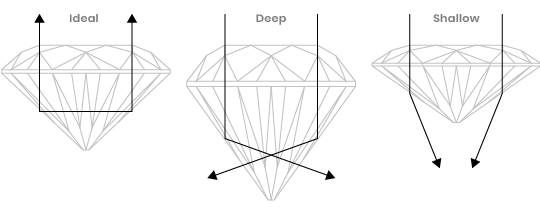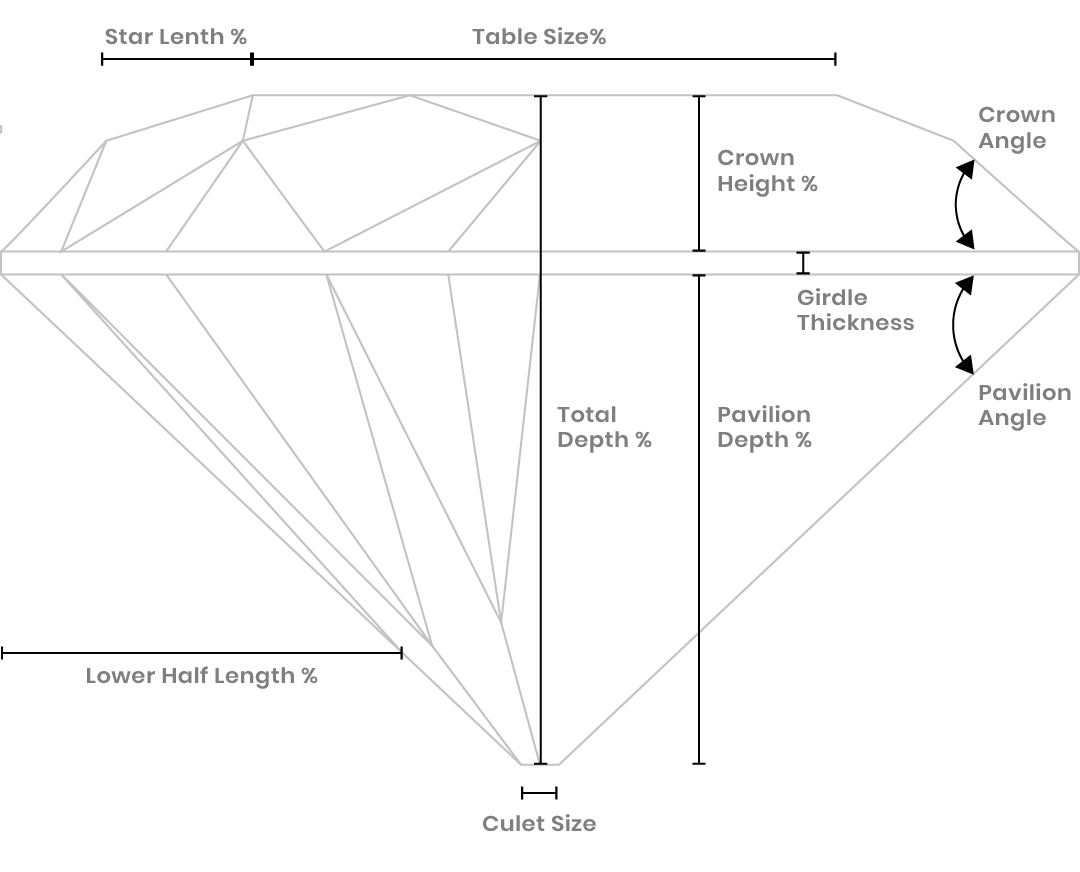Diamond Education
The 4 C'sDiamond Anatomy & Cut Quality
A diamond is comprised of the eight main components. They are Diameter, Table, Crown, Table Spread, Girdle, Pavilion, Depth, and Culet. Below is a brief description of each part of a diamond and its location. Diameter: The width of a polished stone, measured from edge to edge.


Understanding the 4 C’s of Diamonds Shopping
The 4Cs of Diamond Quality is the universal method for assessing the quality of any diamond, anywhere in the world. The creation of the Diamond 4Cs meant two very important things: diamond quality could be communicated in a universal language, and diamond customers could now know exactly what they were about to purchase.
Clarity
Natural diamonds are the result of carbon exposed to tremendous heat and pressure deep in the earth. This process can result in a variety of internal characteristics called ‘inclusions’ and external characteristics called ‘blemishes.’
Evaluating diamond clarity involves determining the number, size, relief, nature, and position of these characteristics, as well as how these affect the overall appearance of the stone. While no diamond is perfectly pure, the closer it comes, the higher its value.


Diamond Clarity Descriptions
- Flawless (FL) No inclusions and no blemishes visible under 10x magnification
- Internally Flawless (IF) No inclusions visible under 10x magnification
- Very, Very Slightly Included (VVS1 and VVS2) Inclusions so slight they are difficult for a skilled grader to see under 10x magnification
- Very Slightly Included (VS1 and VS2) Inclusions are observed with effort under 10x magnification, but can be characterized as minor
- Slightly Included (SI1 and SI2) Inclusions are noticeable under 10x magnification
- Included (I1, I2, and I3) Inclusions are obvious under 10x magnification which may affect transparency and brilliance
Cut
Diamonds are renowned for their ability to transmit light and sparkle so intensely. We often think of a diamond’s cut as shape (round, heart, oval, marquise, pear), but a diamond’s cut grade is really about how well a diamond’s facets interact with light.
Precise artistry and workmanship are required to fashion a stone so its proportions, symmetry and polish deliver the magnificent return of light only possible in a diamond.


Diamond Cut Descriptions
- Brightness: Internal and external white light reflected from a diamond
- Fire: The scattering of white light into all the colors of the rainbow
- Scintillation: The amount of sparkle a diamond produces, and the pattern of light and dark areas caused by reflections within the diamond
Color
The diamond color evaluation of most gem-quality diamonds is based on the absence of color. A chemically pure and structurally perfect diamond has no hue, like a drop of pure water, and consequently, a higher value. GIA’s D-to-Z diamond color-grading system measures the degree of colorlessness by comparing a stone under controlled lighting and precise viewing conditions to masterstones of established color value.
Many of these diamond color distinctions are so subtle that they are invisible to the untrained eye; however, these distinctions make a very big difference in diamond quality and price.


Diamond Color Descriptions
WHY DOES THE COLOR GRADING SYSTEM START AT D?
Before universalized the D-to-Z Color Grading Scale, a variety of other systems were used loosely, from A, B, and C (used without clear definition), to Arabic (0, 1, 2, 3) and Roman (I, II, III) numbers, to descriptive terms like “gem blue” or “blue white,” which are notorious for misinterpretation. So the creators of the Color Scale wanted to start fresh, without any association with earlier systems. Thus the scale starts at the letter D. Very few people still cling to other grading systems, and no other system has the clarity and universal acceptance of the scale.
ARE DIAMONDS GRADED AS Zs CONSIDERED FANCY-COLOR?
No. Naturally colored diamonds outside the normal color range are called fancy-color diamonds. The FTC provides no guidelines for the use of the term “fancy-color” in the US, but there is general agreement in the international trade that fancy-color diamonds are either yellow or brown diamonds that have more color than a Z masterstone or they exhibit a color other than yellow or brown.
Carat (Weight)
Diamond carat weight is the measurement of how much a diamond weighs. A metric “carat” is defined as 200 milligrams.
Each carat can be subdivided into 100 ‘points.’ This allows very precise measurements to the hundredth decimal place. A jeweler may describe the weight of a diamond below one carat by its ‘points’ alone. For instance, the jeweler may refer to a diamond that weighs 0.25 carats as a ‘twenty-five pointer.’ Diamond weights greater than one carat are expressed in carats and decimals. A 1.08 carat stone would be described as ‘one point oh eight carats.’
All else being equal, diamond price increases with diamond carat weight because larger diamonds are more rare and more desirable. But two diamonds of equal carat weight can have very different values (and prices) depending on three other factors of the diamond 4Cs: Clarity, Color, and Cut.
It’s important to remember that a diamond’s value is determined using all of the 4Cs, not just carat weight.


Diamond Weight Descriptions
HOW DID THE CARAT SYSTEM START?
The modern carat system started with the carob seed. Early gem traders used the small, uniform seeds as counterweights in their balance scales. The carat is the same gram weight in every corner of the world.
WHAT ARE “MAGIC SIZES”?
Some weights are considered “magic sizes” – half carat, three-quarter carat, and carat. Visually, there’s little difference between a 0.99 carat diamond and one that weighs a full carat. But the price differences between the two can be significant.
